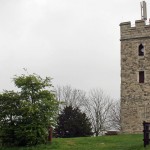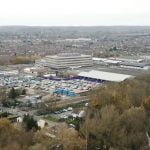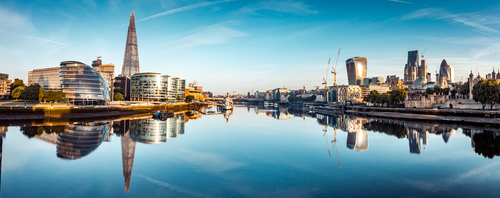
A quick guide to Tower Hamlets
Overview
The Borough of Tower Hamlets forms the core of London’s old ‘East End’. In 1965, the Metropolitan Boroughs of Bethnal Green, Poplar and Stepney were merged to form the London Borough of Tower Hamlets. The southern boundary is formed by the meandering River Thames, the City of London lies to the west, Hackney to the north and Newham lies beyond the River Lea to the east. The borough includes much of the redeveloped Docklands region of London, including West India Docks and Canary Wharf. The Borough of Tower Hamlets has an area of just under 20 km2. At the 2011 UK Census, the population was recorded as 254,100, which is one of the most ethnically diverse throughout the country.
A Very Brief History
Tower Hamlets has a long and colourful history. Archaeological evidence suggests that there was human activity in the area as far back as the Stone and Bronze ages.
The name ‘Tower Hamlets’ sounds very much like a recent trendy designation, but it actually dates back to the 16th century. The first documented mention of it being used was in 1554, when it was applied to describe all the settlements north and east of the Tower of London. The communities were numerous but small, as their development was restricted by the marshy ground common to the area, so they were collectively described as ‘the tower hamlets’. During this time, Brick Lane was already in existence as a path across open countryside, well outside the confines of the City of London.
During the second half of the 17th Century, Large scale urban development began to take place, whereby many streets connecting Brick Lane to the City were laid out and the area began to take on its current appearance. From the late 17th century onwards, successive waves of immigrants arrived in Tower Hamlets. In 1685, the religiously oppressed Huguenots arrived from France, establishing silk weaving at Spitalfields. At the turn of the 19th century, Irish labourers poured in the East End to build London’s rapidly expanding Docklands. From the 1880s, persecuted Jews fleeing eastern and central Europe landed in the borough, establishing the clothing and footwear trade on Middlesex Street (Petticoat Lane) and Commercial Street. From the 1960s onwards, Bangladeshis’, originally drawn to the area as seamen, settled in the area in increasing numbers. By the early 21st century, ethnic minorities accounted for nearly half of the borough’s population.
Prolonged high immigration to the borough obviously led to an abundance of unskilled labour in the area. This, in turn, led to low wages, poor working conditions and general poverty for the majority of the borough’s population. The end of the 18th century saw the formation of unions and workers associations but any change to the lives of the poor was minimal. Along with the rest of London, the East End continued to develop rapidly during the 19th century, leading to extreme overcrowding and a concentration of poor people throughout the area. By the late 19th century, the use of the term “East End” had become commonplace, but was now synonymous with poverty, overcrowding, disease and criminality
World War II devastated much of the East End. Its docks, railways and industry provided an obvious and frequent target for the German Luftwaffe, and the V1 and V2 flying bombs. In total 2,221 civilians were killed, with a further 7,472 being injured. More than 47,000 houses were destroyed and almost another 47,000 damaged to some degree. This led to the dispersal of the population of Tower Hamlets to new suburbs, fuelling a requirement for house building throughout the London area during the 1950s.
Fortuitously, a good number of the borough’s historic buildings survived the war, including the iconic ‘Tower of London’ which was declared UNESCO World Heritage site in 1988.
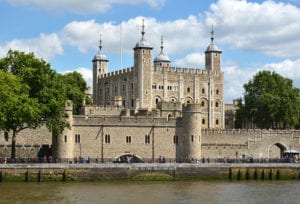
The Tower of London – a UNESCO World Heritage Site
In the 1960s, a spate of dock closures prompted a privately driven development boom. Beginning in 1968, the St. Katharine’s Docks area was transformed by the construction of a hotel, a trade centre, apartment blocks and a marina. In the 1980s, the Canary Wharf development and the Isle of Dogs regeneration formed part of the London Docklands Redevelopment Project, which did much to improve the area. In the late 20th century, the borough became a hub for the printing and publishing of newspapers, as firms began to relocate from their traditional home of London’s Fleet Street.
Did you know?
- Whitechapel, the location of the notorious 19th century ‘Jack the Ripper’ murders, is a district of Tower Hamlets
- The Two Puddings Pub, which was the unofficial HQ of the notorious 1960s East End gangsters, the Kray twins, is also in Tower Hamlets
- Superstition holds that if the resident ravens at the Tower of London ever leave, ”the Crown will fall and Britain with it”
Getting Around!
Tower Hamlets is well connected to the rest of the London by several Underground lines, the Overground and the Dockland Light Railway (DLR). The Central, Hammersmith & City and District lines serve the north part of the borough, while the DLR and Circle serve the south, and the Overground connects the two regions. The riverboat services, accessible directly from St Katherine’s Docks, provide an alternative mode of transport, getting commuters to Canary Wharf in around 10 minutes.
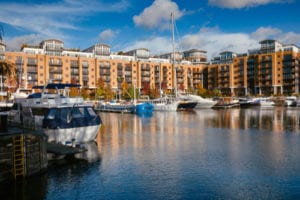
St Katherine’s Dock – Tower Hamlets
Railway, Docklands Light Railway and Underground stations situated with the Borough of Tower Hamlets are:
London Underground (Tube) stations
- Bethnal Green
- Canary Wharf
- Stepney Green
- Tower Hill
- Whitechapel
Dockland Light Railway (DLR) stations
- All Saints
- Blackwall
- Crossharbour
- Devons Road
- East India
- Heron Quays
- Island Gardens
- Langdon Park
- Limehouse station
- Mile End station
- Mudchute
- Poplar
- South Quay
- West India Quay
- Westferry
Railway stations
- Aldgate East
- Bethnal Green
- Bow Church
- Bow Road
- Bromley-by-Bow
- Canary Wharf
- Limehouse station
- Shadwell
- Shoreditch High Street
- Wapping
- Whitechapel
Things to see and do!
Some of London’s best tourist attractions are in and around Tower Hamlets. The following list highlights some of the Borough’s top sights:
- Tower of London – Medieval castle housing the Crown Jewels
- Tower Bridge – Iconic Victorian turreted bridge
- Canary Wharf – skyscrapers & Docklands Museum
- Brick Lane – Street art, shopping, food, fashion, and art
- Old Spitalfields Market – Covered Victorian market hall
- St Katharine Docks Marina – Restaurants, cafes, shops & a marina
- Victoria Park, London – City’s oldest purpose-built public park
- Museum of London Docklands – History of Thames trade in ex-warehouse
- V&A Museum of Childhood – Toys & artefacts from 1600 onwards
- Dennis Severs’ House – Restored 18th-century East End townhouse
- Whitechapel Gallery – Groundbreaking modern art exhibitions and workshops
- The Shard – UK’s tallest building, with restaurants, offices, hotel and viewing platform.
- Tower Millennium Pier – Pier on the Thames used for river buses, cruises & charter boats
- Mudchute Park and Farm – Large city farm with rare breed animals
- London Wall – Roman empire, history, and monument
- Traitors’ Gate – Historic entrance to the Tudor Prison, the Tower of London
- London Bridge – 1970s bridge spanning the River Thames
- Borough Market – Historic Market with fresh produce & groceries
- HMS Belfast – Floating museum of ex-Royal Navy battle cruiser
- Jack the Ripper Museum – Grisly museum on 6 floors which tells the story of the notorious 1888 East End murders
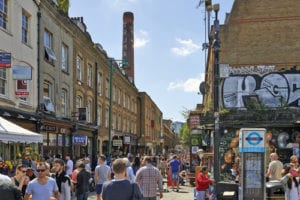
Brick Lane – a mecca for diners and shoppers
Where to stay?
If you’re on a budget there are some offerings of hostel style accommodation in or close to Tower Hamlets. There’s plenty of B & B/Guesthouse/Basic Hotel accommodation. If you’re looking for a bit more luxury then there’s also plenty 3, 4 and 5-star hotels in the area. An alternative would be to rent an apartment – most have no minimum let period. While the majority of apartments cater to couples, some can accommodate up to 6 people. Indicative prices for the most readily available types of accommodation/per night, based on 2 adults sharing are as follows:
B & B/Guesthouse/Basic Hotel: £40 – £90
3/4/5 Star Hotel: £90 – £250
Apartments vary greatly based on no. of available berths, location and standard



